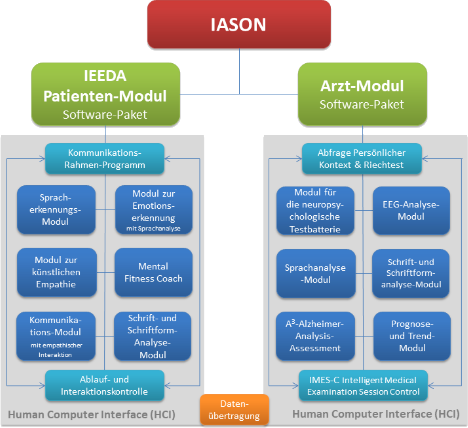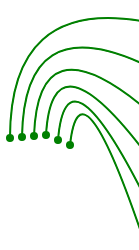In the IASON system, two initially separate software packages are programmed:
the patient module (the IEEDA) and the physician module.
In case of the patient module the following modules will be programmed
- a speech recognition sub-module with detection of the sub-symbolic components of the speech signal,
- an emotion recognition sub-moduleas well as a communication sub-module with empathic interaction, which uses the aforementioned sub-modules to enable communication as close to the patient as possible.
- In addition, there is a "mental fitness coach" (MFC) with graphic games, which are also used to capture components of the written form.
The individual sub-modules are each programmed and continuously improved on the basis of the patient data acquired. Speech, communication and emotion recognition sub-modules must react to the individual characteristics of the patients.
The MFC sub-module is intended to be used for employment, mental training and especially for the daily support of patients, carers and relatives.
When creating the HCI (Human Computer Interface), clarity and ease of use are of utmost importance, since the digital terminal device on which IEEDA is implemented is used by patients in an intuitive (mostly verbal) way.

The physician module consists of several sub-modules that contribute to differential AD diagnostics.
The results of the sub-modules of the neuropsychological test battery together
- with the recording of the personal context and the smell test,
- the EEG analysis,
- AI-based speech analysis (e.g. prosody)
- and the writing and written form analysis,
serve as input variables for the "Alzheimer Analysis Assessment (A³)" submodule. The result is an index value for the presence of AD for the physician. A prognosis sub-module based on this index, which is continuously fed with the patient's data during all further examinations, provides a probability of the further development of the patient's AD. It is therefore also the responsibility of the physician to make a final diagnosis.
In contrast to previous, mainly imaging, diagnostics, the speech analysis data continuously collected by the patient module together with the repeated examinations with the help of the physician module of the IASON system enables a progress control with prognosis (prognosis submodule).
Of course, this software project pays special attention to user-friendliness in the communication with the physician module. A specific intelligent control program (IMES-C) takes over this function for the executing physician.
The overall composition of the software packages for physicians and patients in the IASON system is intended to ensure that medical diagnostics are not replaced, but that they are optimally supported by IASON. In this way, the greatest possible benefit for the patient is achieved.
Suitable encryptions must be created for all data collected and data protection must be ensured. Furthermore, the respective interfaces for the software among each other, the communication with the hardware, as well as the external communication with the doctor, nurse, caregivers and relatives must be designed in a suitable form - as intuitive as possible.


 English
English  Deutsch
Deutsch